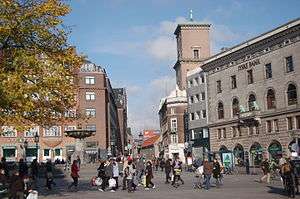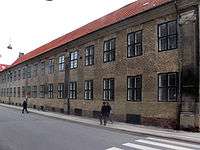Nørregade

Nørregade (literally "North Street") is a street in central Copenhagen, Denmark, connecting Gammeltorv to Nørre Voldgade.
History

.jpg)
In the Middle Ages, Nørregade was the broadest street in Copenhagen.[1] Its name testifies Gammeltorv's status as the centre of the city in that day. Copenhagen's second city hall was in the late 14th century built on the corner of Nørregade and Studiestræde. It was later used as bishop's palace. The Northn City Gate was located at the northern end of the street until 1671 when it was moved to the end of newly established Frederiksborggade further to the west.
The entire street was almost completely destroyed in the Copenhagen Fire of 1728 while the Fire of 1795 only affected its southern end. The British Bombardment of Copenhagen in 1807 hit the street hard since the British aimed for the tower of Church of Our Lady, Copenhagen's tallest building, hitting it on the third day.
Notable buildings and residents

Church of Our Lady was in its current form designed by Christian Frederik Hansen. The Bishop's House on the opposite side of the street was built in 1732 but adapted by Martin Nyrop in 1896.[2]
Folketeatret at No. 39 opened in 1857 but the interior was completely renewed by Vilhelm Dahlerup in 1889. The building is from 1846 and was designed by H. C. Stilling.[3]
The Telephone House (No. 21-23), now known as Sankt Petri Passage, is the former headquartwers of KTAS, Denmark's first telephone company. It was built between 1900 and 1909 as a replacement for the telephone central at Jorcks Passage. A series of interior courtyards creates a passageway through the complex, connecting Nørregade to larslejsstræde on the other side of the block.[4]
The former department store Daells Varehus at No. 12;ndash&20 was one of the earliest Functionalist buildings in Copenhagen. It has now been converted into five-star Hotel Sankt Petri whose main entrance has been moved to Krystalgade.
The Povl Badstuber House at No. 13 is the street's only surviving example of the townhouses which were built along the street in the years after the Fire of 1728. It is from 1730.[5]
See also
References
- ↑ "Nørregade" (in Danish). indenforvoldene.dk. Retrieved 2013-10-24.
- ↑ "Bispegården". Selskabet for Københavns Historie. Retrieved 2011-04-28.
- ↑ "Nørregade 39/Nørre Voldgade 50". indenforvoldene.dk. Retrieved 2013-10-25.
- ↑ "Nørregade 21-33-35-37a-b / Larslejsstræde 4-6/Nørre Voldgade 38-44". indenforvoldene.dk. Retrieved 2013-10-25.
- ↑ "Nørregade 13 / Sankt Peders Stræde 3". indenforvoldene.dk. Retrieved 2013-10-25.
External links
| Wikimedia Commons has media related to Nørregade. |
- Nørregade on indenforvoldene.dk
Coordinates: 55°40′51″N 12°34′16″E / 55.6809°N 12.5712°E